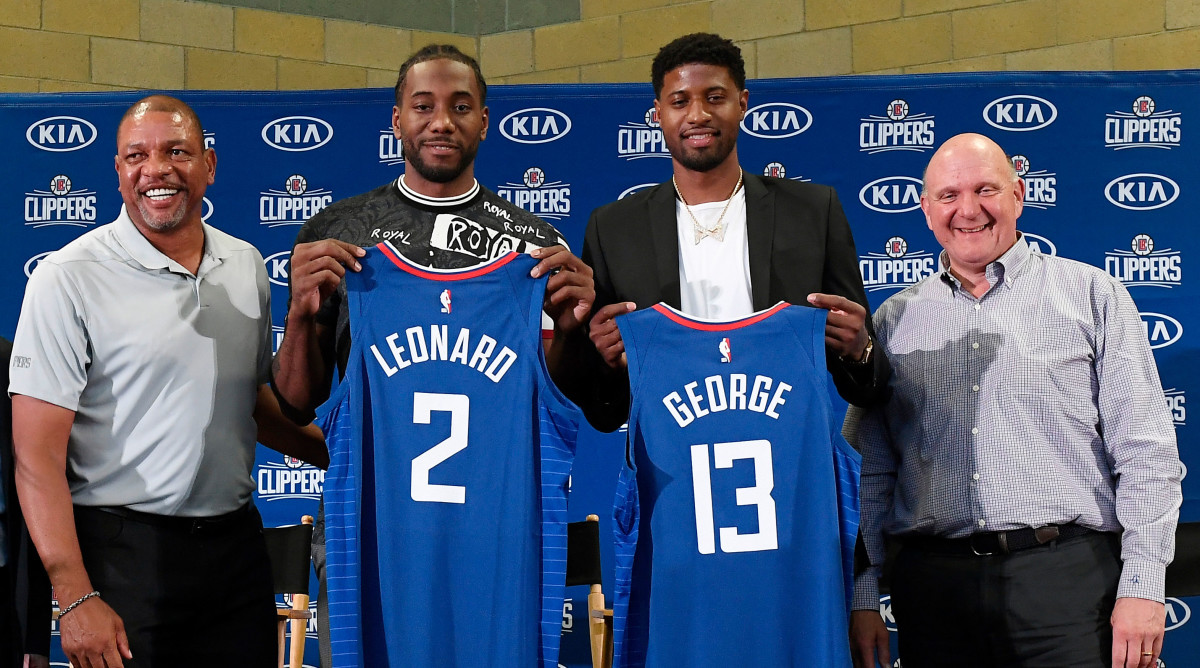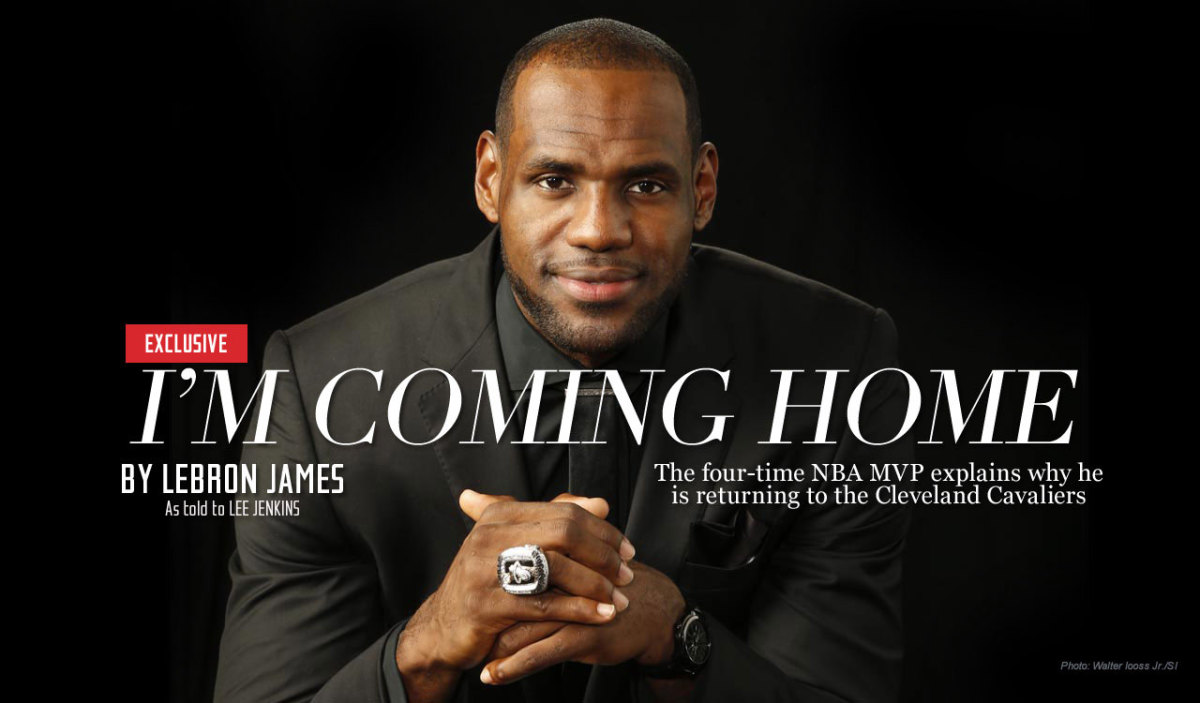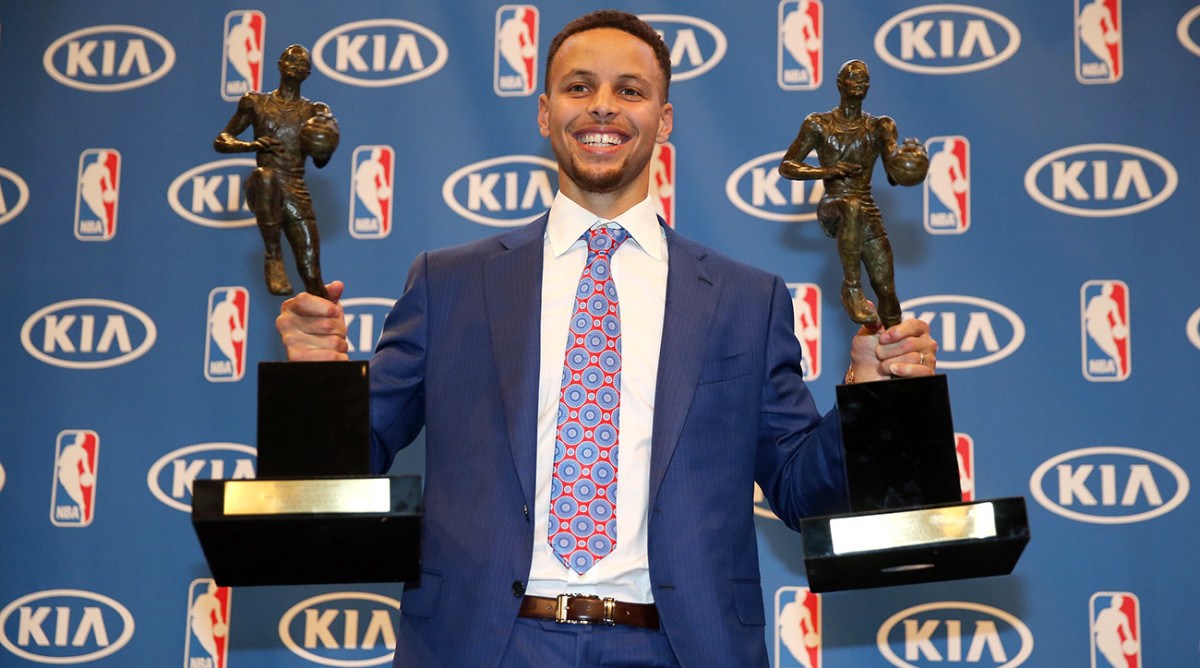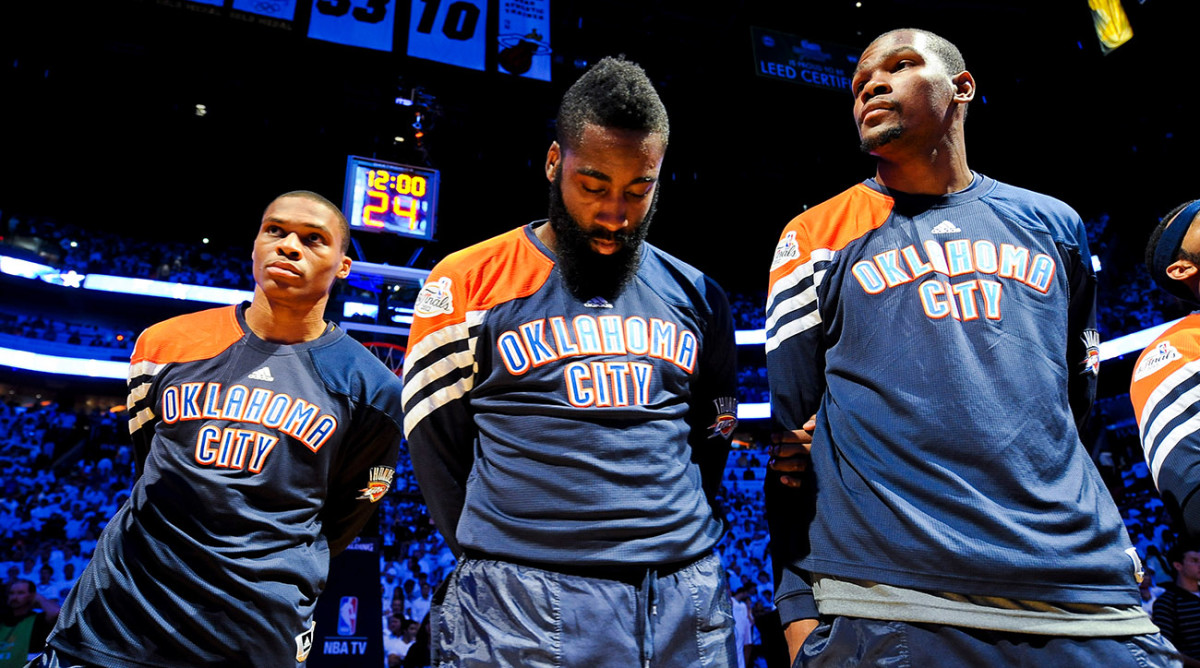The Biggest NBA Stories of the Decade

The NBA is nearing the end of the decade, and this week Sports Illustrated has celebrated this occasion by rolling out our All-Decade teams. As a companion to that project, I was asked to compile a list of the ten biggest basketball stories of the past decade. The project here is pretty self-explanatory, so I'll just add two notes before we get rolling. First, I've added a few pieces of internet ephemera to each section, because after a decade of covering this sport, my brain isn't capable of contextualizing any of these memories without remembering at least one stupid artifact from NBA Twitter.
Second, it was very difficult to narrow the list to 10 entries. So for various reasons, honorable mention goes to: Russell Westbrook and the MVP that we'll be arguing about for the next 15 years, Michael Jordan's Hall of Fame Speech (ineligible because it came in September 2009), the Clippers re-signing DeAndre Jordan in July 2014, Dwight Howard and the 2012 Lakers, Rajon Rondo and the Three Alphas Bulls, Game 6 of the 2013 Finals, San Antonio's revenge tour the following year, "How u?" and the 2011 Lockout, "how's it goink" and Phil Jackson truthering the three-point revolution mere weeks before the Warriors took over the entire league, Jeremy Lin on the Knicks in 2012, the Nets-Celtics trade in June of that year, and Game 6 between OKC and Golden State in 2016. Linsanity and OKC's Game 6 were the toughest omissions. Also, we can't forget Kobe Bryant's seven month retirement tour, 65 Lakers losses, and 60 points on 50 shots to win his final game at Staples Center. What a ride.
Now let's get into the top 10.
All-Decade Coverage: Third Team | Second Team | First Team

10. Kawhi Leonard's wild year
To recap: Kawhi finished the second round against the Sixers with more points in a playoff series (243) than anyone since Michael Jordan in 1993, including a mind-boggling game winner to steal Game 7. Then came the Bucks series, where his defense helped short circuit the MVP of the league and he averaged 29.8 ppg on the other end. And then the Finals, when he buried the Warriors in six games—particularly in the second half of a Game 4 win at Oracle to break the series wide open. We know all this, and we all just watched it happen, but the madness of that run is only going to get more incredible as the years pass.
But all of the above is only half the reason he's on this list. Remember Tony Parker telling reporters that his injury was "100 times worse" than Kawhi's? Or the report that Kawhi was sequestered to a different part of the building when Spurs personnel tried to meet him at a hotel in New York City. Or at least two dozen headlines like this: Spurs' Gregg Popovich offers vague update on Kawhi Leonard situation: Talk to 'his group'. Kawhi's exit from San Antonio remains one of the strangest things to happen in the NBA this century. Then came the free agency sweepstakes that included helicopter surveillance, vigilante Reddit journalism, and a banana in the Lakers' tail pipe. That story culminated with a move to the Clippers that came in conjunction with a Paul George trade and a literal earthquake in the middle of Vegas Summer League.
There's a lot to parse in all of that, but on the broadest level, this was a decade defined by superstars, and it ended with a stunning testament to the power of a superstar who even his own peers never really described in those terms. What's more, in the midst of an NBA media economy that's increasingly fueled by year-round speculation, the entire league was upended by a player who rendered all of that speculation useless. No one knew what Kawhi was thinking, ever. Not with the Spurs. Not with the Raptors. Not in free agency. Honestly, no one knows him now. But we know his work.
Internet artifact #1: Cris Carter, press secretary.
Internet artifact #2:Stalking Kawhi at a gas station.
Internet artifact #3:Kawhi's answer when asked what a title would mean to Toronto.
9. The Mavericks win in 2011
The Heat went on to win their own well-deserved titles in successive seasons, but that particular year, the Mavs felt right. Whether it was Dirk silencing critics (and fake coughs) or Jason Terry responding to Dwyane Wade's Game 2 pose in front of the Dallas bench, that series was like a "Ball Don't Lie" moment for the entire sport. To that point: Any basketball fan who hasn't read Ian Thomsen's book on the '10-'11 NBA season should do so when they can.
That Mavs win came at a time when lots of mainstream fans were sick of the NBA and convinced that LeBron's Decision in 2010 had ruined the competitive balance of the league. Dirk, Terry, Tyson Chandler and Shawn Marion laid waste to that assumption and gave the world one of the most enjoyable Finals stories the league had seen in 20 years. But maybe even more important, the Dallas win helped LeBron, too. As often as critics have held that Mavs performance against LeBron (he averaged 17.8 ppg on just 15 shots-per-game), I think the better question is to wonder how LeBron would have been perceived if he'd won that series in 2011. There's a good chance that a majority of mainstream fans would have resented the Heat more than ever, discounted any subsequent titles in Miami, and convinced themselves that an entire era of the NBA had been poisoned by stars who chose camaraderie over competition. Considering LeBron was about to become the face of the NBA for the next 10 years, that outcome would have been suboptimal.
Instead, Jason Terry scored 18 points in the first half of Game 6 and then Dirk took over and won it. The world saw LeBron tested and fail and forced to respond the following year. All of that made his eventual titles a lot more satisfying than they might have been otherwise.
Internet artifact #1:Jason Terry's Larry O'Brien tattoo.
Internet artifact #2:DeShawn Stevenson's shirt.
Internet artifact #3:Birdman lost $2 million on the 2011 Finals.

8. LeBron James goes back to Cleveland
Most of the world's best ideas seem obvious in retrospect, and such is the case with LeBron going back to Cleveland. Dwyane Wade and the roster in Miami was getting older. The Heat had limited flexibility to add any meaningful firepower after running out of gas in the '14 Finals. LeBron wanted more control than Miami would ever be willing to cede. Meanwhile, the Cavs offered a young supporting cast that would give LeBron the chance to extend his reign through the second half of the decade. Dan Gilbert's desperation meant he would have unprecedented power in Cleveland—signing a series of one-year deals would only compound that leverage—and winning with the Cavs would give him exactly the sort of bulletproof narrative that would help him chase Jordan's ghost.
Looking back, all the chess pieces are easily identified. Of course he went home. It fits with everything we've come to expect from LeBron over the course of the decade. It will be remembered by most basketball fans less as a gamble than as a masterstroke from a superstar who will one day be mythologized for his ability to conjure empires wherever he went. And ... All of those interpretations are mostly correct, so I'm not here to complain too much. All I will say is that even if the Cleveland rationale has become self-explanatory in hindsight, we really shouldn't undersell the audacity of this move at the time.
It was unthinkable that LeBron would ever trust Gilbert right up until he did, trusting Kyrie Irving and Dion Waiters was its own gamble, and leaving that Miami roster wasn't the no-brainer it looks like now that we know Chris Bosh's career was mostly over by 2014. If the Cavs homecoming fits with everything we've come to understand about LeBron, I'd argue we learned most of those lessons in July 2014. The Decision was clumsier, a little more desperate, and a little more naive. When he went back to the Cavs we saw what LeBron looks like with the poise to see all the angles and the confidence to exploit them. Cleveland was the best move from a marketing standpoint, a shrewd means of self-preservation, and a decision that betrayed all the bigger-than-basketball ambitions that have come to define him ever since.
Internet artifact #1:Pat Riley with the best press conference of the decade.
Internet artifact #2:Dan Gilbert's plane tracking controversy.
Internet artifact #3:Stop trying to find a way to FIT OUT.
7. The Process, May 2013 - June 2018
The Sixers and the Process could submit no less than six different entries that would deserve consideration for this list. 1) Joel Embiid's first four years. 2) Sam Hinkie, the Process and all the controversy that came with both. 3) Hinkie's firing and the Colangelo family taking control of the team, allegedly with Adam Silver's blessing. 4) The trade for Markelle Fultz, hundreds of NBA writers praising the deal, and thousands of Sixers fans taking to the internet to address critics like they'd just won a title, thereby jinxing the era almost immediately. 5) Fultz wrecking the mechanics on his jumpshot, or getting the yips, or suffering from thoracic outlet syndrome or ... we still have no idea exactly what happened. And then 6) there was Bryan Colangelo and his normal collars. Colangelo met his demise in the midst of a Twitter burner account scandal and an in-depth investigation led by a noted Nerlens Noel and Sam Hinkie zealot working with the help of a still-anonymous tipster who entered his DMs.
I'm putting all of those episodes together because it's impossible to choose one that properly signifies how baffling this team has been for almost the entire decade. Books will be written at the end of all this. Documentaries will be made. The Process will continue to be trusted. And on that last point, the most sincere takeaway from this Sixers era: Something worked here.
The Process created a community of fans that were easy to caricature, particularly since almost all of this happened online. Fans openly admitted to rooting for losses and not caring about entire seasons, titles were promised based solely on the strength of an asset portfolio, and the league itself was concerned enough by the culture surrounding the Process that it passed NBA Lottery reforms that went into effect beginning last year. But for all the hand-wringing among critics, the energy surrounding the Process on blogs and podcasts and Twitter has given way to a generation of fans who are incredibly engaged in the real world. The Sixers have one of the loudest stadiums in basketball, they're one of the four or five showcase teams in the league, and more people care about basketball in Philadelphia today than they do in 90 percent of the other cities in the NBA. We can (and will!) spend the next 20 years having sporadic arguments about how the Process was executed or whether it was ever as brilliant and groundbreaking as advertised, but no one can deny that something worked in Philadelphia.
Internet artifact #1:This "Normal Collars" game.
Internet artifact #2: Hinkie's resignation letter.
Internet artifact #3:Sad Sixers girl.
Internet artifact #4:This draft night podcast.
6. LeBron wins in 2016
We've already been over the Cleveland move so I won't belabor this point, but the 2016 Finals is when it all paid dividends. The Cavs fit wasn't nearly as seamless as LeBron hoped it might be (RIP Waiters/LeBron era) and the Cavs were quickly outflanked by a Warriors team that was better and more dynamic on both ends of the floor. By 2016, they had transformed into a 73-win juggernaut that captured the imagination of the whole country. And all of this ultimately worked in LeBron's favor and created an opportunity to shock the world and cement his place in history.
It was a near-perfect inversion of the 2011 Finals story, complete with a Cavs supporting cast that was impossible to root against. And if that Mavs series was a "Ball Don't Lie" moment for LeBron, then so was this one. Everyone knew he was one of the three greatest players ever, but he needed one accomplishment that the world could point to when it was time to describe what made him legendary. That was this series--where LeBron led all players in points, rebounds, assists, minutes, blocks, and steals.
Internet artifact #1:LeBron's sad batman Instagram during the height of the Warriors' run.
Internet artifact #2:Watching Amy Schumer as Golden State won its 72nd game.
Internet artifact #3:This photo.

5. Steph and the Warriors take over the league
The Warriors won a title in 2015, but it wasn't until 2016 that it became clear we were watching a historically great team and a revolutionary superstar in Curry. Their season was so dominant that anyone still questioning an NBA offense built on threes was immediately treated like climate change denier. Curry was so thrilling that he won his second straight MVP and did so uninanmously. And then LeBron beat all of them in the Finals, obviously. So why are Curry and the Warriors higher on this list?
That Cavs title was great. Beyond LeBron, there were also four incredible Kyrie performances, one Kevin Love stop, and a summer full of iconic social media celebrations from Channing Frye, Richard Jefferson, and Matthew Dellavedova. But that Cavs title was essentially an outlier. We'll remember Cleveland's title as the sort of perfect storm that happens once in a generation. Curry and the Warriors, on the other hand, were the generation itself. They ushered in a perimeter-oriented offense that continues to define the league. The nucleus featured three Hall of Famers at the peak of their powers, and then they recruited a fourth. As for Curry, specifically, he's been weirdly polarizing among his peers and various skeptics will always resent him, but none of that should overshadow the basic realities of his career. When all of this is done, future generations will look back stunned at how amazing he's been. At minimum, he's the greatest shooter of all time. There's also a chance that he'll finish his career with a few more titles and we'll have to start asking bigger questions about where he ranks in history.
We'll see how it ends, but 2016 is where those questions began. This February game in Oklahoma City remains one of the craziest basketball experiences of my life—not just because of the 38-footer to win it at the buzzer, but because of all the delirium that game epitomized at the time. No one could understand how any of this was happening, how much longer it would last, and what it might mean for the future. Curry and the Warriors were bending reality in 2016. Truly, the entire regular season felt like this.
Internet artifact #1:Joe Lacob's "Light Years" interview.
Internet artifact #2: 11 Klay three-pointers in Game 6
Internet artifact #3:Draymond Green and the Oklahoma state police at halftime of that February OKC game.
4. Kevin Durant goes to Golden State
KD in Golden State was more strange and confusing than it ever was cool. We thought the Warriors might be the best team ever assembled, but they rarely played that way. We occasionally thought we were at least getting to know KD and what mattered to him, but then he'd say something that made us question all our assumptions. We worried KD joining a 73-win would ruin the competitive balance of the NBA and ... actually, on that front, everyone was right.
Durant's move makes the list because its impact on the NBA was undeniable. The scales of the Cavs-Warriors rivalry were tilted so dramatically that first Kyrie Irving left, and then LeBron James did the same. It's an open question as to whether either move happens when it did if Durant never goes to the Bay. There's a chance that all the drama we've seen elsewhere around the NBA in the past few years is at least partly a by-product of universal restlessness knowing that the title was all but unwinnable if the Warriors were healthy. Even Durant, himself, seemed to be restless and irritiable through most of this season, and that was before the heartbreaking injury in the Finals this June. In the end, a fresh start was healthy for everyone involved. Here's to hoping that both KD and the Warriors have plenty more chapters in their stories from here. Both sides of the partnership make the whole league more fun, but together, it was never quite as satisfying as it was supposed to be.
Internet artifact #1:The damn burner accounts.
Internet artifact #2: KD in November, reminding the world how amazing he is.

3. The James Harden trade
I know. People are so tired of talking about the James Harden trade that we're even tired of people saying they're tired of talking about the Harden trade. Having said that... the Harden trade absolutely has to be on the list. This was a decade dominated by either LeBron James and Steph Curry. There was one team that had a reasonable shot at upstaging both of them for the majority of that run, but the Thunder were broken apart before they ever had a chance to hit their prime. We'll never know exactly how great OKC could've been in the alternate timeline where the Thunder pay an extra $6 million to give Harden a max extension in the fall of 2012. The whole decade might have played out very, very differently. That possibility is obvious and it's been discussed ad nauseam, but that doesn't make it any less true.
As each player has grown and won MVPs, the history has only gotten harder to ignore. I will go to my grave baffled that OKC refused to amnesty Kendrick Perkins to create the extra money for Harden and alleviate luxury tax concerns (Perkins finished the following season with the worst PER in NBA Playoff history). On a more global level, the Harden trade is basketball's reminder that for every perfect storm of luck and foresight that ends with a dynasty, there are stories of the inverse that will drive us crazy until end of time. While Golden State got right to the edge of a Klay Thompson trade and then turned back, OKC took the plunge, separated its Hall of Famers, and the franchise never totally recovered.
Internet artifact #1:This picture from the Finals resurfaces once every two months and never fails to make me depressed.
Internet artifact #2:This picture still makes me happy.
2. Donald Sterling loses the Clippers
The worst part of the Sterling audio was that it wasn't surprising. Anyone who had followed basketball closely had at least vague knowledge of Sterling's terrible history on race, and once those tapes came to light, it became particularly embarrassing to know that the entire basketball world had allowed him to continuing owning a team and leering his way around the NBA year after year. Meanwhile, the days following the release of the Sterling audio were full of protests, outrage, and genuine confusion about what the league could, or would, do. All of it unfolded in the middle of the NBA Playoffs, which only added to the chaos.
What came next helped transform the story. Players condemned Sterling loudly and without reservation, including LeBron James, who said, "There's no room for Donald Sterling in the NBA—there is no room for him. Obviously, if the reports are true it's unacceptable in our league. It doesn't matter, white, black or Hispanic—all across the races it's unacceptable. As the commissioner of our league they have to make a stand. They have to be very aggressive with it. I don't know what it will be, but we can't have that in our league." Meanwhile, Steph Curry, Andre Iguodala, and the Warriors were planning a boycott of their playoff game against the Clippers.
Then Adam Silver stepped in and banned Sterling for life. The punishment exceeded most expectations and it sent a message to players that the league heard them. It set a tone for Silver's tenure as commissioner, the partnership the league wanted to cultivate with players, and the roles they can all play in promoting social justice. Granted, those are missions with nuanced dynamics and varying effectiveness. They require more in-depth discussion than this list can offer. But the bottom line is that of the mood of the NBA as a business changed when Sterling was banned. It was the beginning of the era we have today.
Internet artifact #1:V. Stiviano's Paparazzi visors
1. The Decision
It wasn't perfect, and, in retrospect, if LeBron was leaving Cleveland, it may not have been a wise choice to announce it on national televsion in a groundbreaking spectacle that the whole world was watching. (He knew the move would be unpopular in Ohio—that’s why they did it in Greenwich.) But even with hindsight, I’m not sure anyone would do anything different. As a player who took control of his destiny on the court and of his marketing platforms elsewhere, LeBron set the tone for the next 10 years in the NBA. An entire generation now understands their leverage better than ever, teams have been forced to adjust accordingly, and the entire league is learning as we go. That's the obvious impact here. For that development alone, the Decision would be an easy choice at number one.
But beyond the fundamentals of the player power revolution that began with Jim Gray at the Boys and Girls Club, the more interesting impact is in the way we talk about any of this. In the wake of the Decision, LeBron endured more criticism than any athlete we've seen this century. Some of it was fair, but a lot of it was incredibly personal, paternalistic, and ugly. Basically a lot of columns that weren't quite as bad as the Dan Gilbert letter, but they were in the same territory. There were at least 11 months when it felt like almost the entire country was rooting for the Miami Heat to fail. It wasn't until they finally won, when LeBron weathered adversity to play the best basketball of his life, that everyone began to sober up and regret some of what was said in that first year.
Fans and media learned from that experience. The guilt in the wake of the Decision led to a correction through the rest of the decade. There was more humanity in the way we discussed players and the way we viewed their careers and their pursuits off the floor. This shift has manifested itself in all kinds of ways, but most obviously it has meant that free agency is now an annual celebration, speculation runs year-round, players are rarely criticized for pursuing their preferred path, and everyone—media, fans, players—leans into this new paradigm. But of course, that culture has limits, too. Fans could get tired of annual turnover. TV ratings may not match web traffic. Owners sound like they're getting restless again. In July, Adam Silver expressed his own misgivings about the current player movement ecosystem.
As tensions emerge from various corners, it's going to be really interesting to see how much the current dynamics change in the decade to come. The one thing we know is that the NBA world has come a long way from the Greenwich Boys and Girls club. I wonder where it's going next.
Internet artifact #1:The book-to-VitaminWater ratio.
Internet artifact #2:LeBron's first tweet.
Internet artifact #3:"What should I do?"
Internet artifact #4:Game 6 in Boston.
